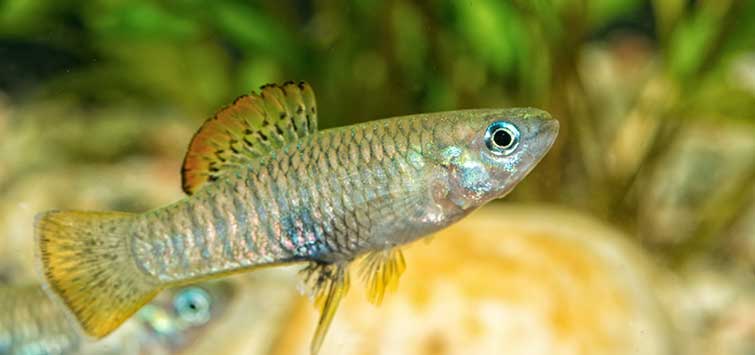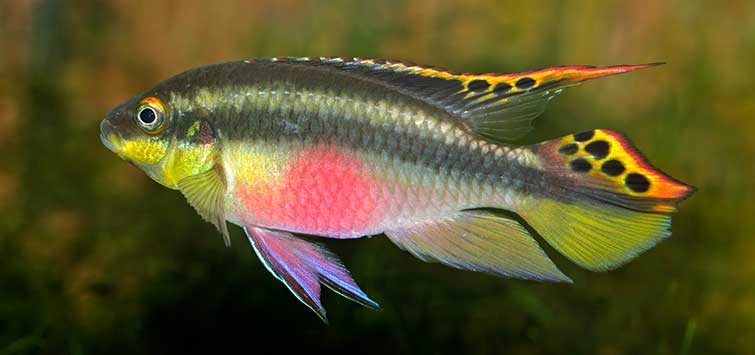Brachys from Costa Rica
Author: Uwe Dost
An explorer-biologist traveled to Costa Rica collect two species of Brachyrhaphis—little livebearers with big, bad attitudes—and found them to be surprisingly great aquarium fish.
Findings from Costa Rica
After our first trip to Costa Rica years ago, we brought some lace brachys home with us to Germany despite reading many times before that the brachy minnow should not be brought home due to bad attitude, and the fact that it would not even spare its own young. This livebearer was so nicely colored when caught in the wild, however, that I couldn’t resist bringing it home and trying my luck.
These agile fishes didn’t disappoint me and turned out to be much easier to work with than commonly assumed. Elated by this experience, we tried to find some more brachy species on another journey to Costa Rica.
Brachyrhaphis rhabdophora in the Wild
The lace brachy is widespread throughout the Pacific coast of Costa Rica. We found this species in nearly every creek on the Nicoya Peninsula. The average water parameters measured were 11° dGH, 9° KH, and pH 7.0, but we also caught this fish in a creek at the hillside of the RincÓn de la Vieja volcano with water parameters of 5° dGH, 3° KH, pH 6.5.
The base color varies from gray to light brown depending on where the specimens are collected, and a black net-like pattern covers the whole body. Black bars can appear on their sides depending on mood. The color of the dorsal fin varies from light yellow to bright orange, and the black color of the tailfin contrasts nicely against the bright colors.
Individuals coming from the road to CaÑas, TilarÁn had a tailfin that was primarily black, with male fishes sporting a shiny yellow border. The gonopodium of the male is totally black. Female fishes show a yellow to orange pattern with black around it on their dorsal fins. Females have a thicker, stronger build compared to the slender males who are smaller, maxing out at 4 cm (1½ inches).
In the Aquarium
In the transport containers, huge females bit and damaged the fins of smaller females and males. In overcrowded tanks without enough shelter, the fish will become aggressive and bite each other, resulting in damaged fins and even death. But in aquariums with ample space, the lace brachy is much less aggressive and interaction between the fish seems more playful. As with many other aggressive species, it is easier to keep larger schools so the bullying is evenly distributed among weaker specimens and won’t focus on a single individual.
A female I captured on my first trip in 1992 grew to a length of 7 cm (2¾ inches) and only had fry four times. When I caught her I estimated that she was two to three years old. Most of her offspring are females. The F1 generation grew to about 5 to 6 cm (2 to 2¼ inches) after two years.
Oftentimes they will look pregnant and drop fry, but it’s been over a year and a half and I haven’t found any juveniles—not surprising given that the literature reports them to be highly cannibalistic. Also, since large females can easily gulp down housefly larvae, medium-sized crickets, or adult Gammarus shrimp, they could easily gulp down their own offspring.
But to my great surprise, I found some fry swimming in my tank one day. I immediately put them in a breeding box so they could be raised separately, and shortly afterwards I found some more fry. After filling up three breeding boxes with brachy fry, I left the next set of fry in the tank and some offspring grew up even there. Meanwhile, even though there are a lot of fishes of different sizes swimming in my tank, I know that less than 50 percent will be males.
With such a large school of fish I am unable to closely observe individuals, but I believe that the females breed late. I also think that the male’s gonopodium develops when it reaches a size of about 2 cm (¾ inch) or at about half a year old, and females will start showing large bellies at a size of about 3 cm (1 inch). Females can only become pregnant at certain times although they can reach an age of seven years or more. Tankmates for lace brachys should be other robust fishes, certainly not wimpy ones.
The Cardinal Brachy
The cardinal brachy Brachyrhaphis roseni is behaviorally and physically very similar to the lace brachy. This species was first described in 1988 by William A. Bussing but was known earlier—in the 1960s—by livebearer enthusiasts.
As you might infer from the name of the fish, it shows red colors. All males, not only the dominant one (the alpha male), have a fire-red dorsal fin. The tailfin shows a red color and even the back gleams with a red color. The gonopodium of the males is dichromatic, black on top and yellow underneath. The dorsal fin and tailfin of the females are bordered with an iridescent whitish blue.
We found this species at the Pacific lowlands in a creek along the Pan-American Highway in the southwest of Costa Rica near the border with Panama. The creek bed was composed of large boulders. The cardinal brachys stay with some Rivulus hildebrandi near the shore in the shallow water. It was difficult to catch them with the net there because of the many cavities between the boulders that served as hiding spots.
The deeper part of this body of water was populated with the Costa Rican or Gill´s molly Poecilia gillii, Curimata sp., Astyanax sp., and some cichlids. The cardinal Brachyrhaphis, a species generally known to be rough character, were not dominant in this habitat and were attacked by the bigger fishes. The water parameters here were 3° dGH, 3° KH, and pH 7.0.
Keeping the cardinal brachy in the aquarium didn’t differ much from keeping the lace brachy. In a tank they reach a larger size than what we found in the wild, where we observed and caught only relatively small specimens.
This splendid species could also be kept together with fishes of the same size. For example, I tried to keep them with blue eyes Priapella intermedia and gold dust mollies. If they are kept in densely planted tank, some fry will be able to grow up.
I am extremely happy that I took the chance on these infamous fishes. They have proved to be wonderful aquarium specimens, colorful, interesting, and nowhere near as aggressive as I had feared. Perhaps my experiences will encourage others to try brachys. I don’t think anyone will be disappointed with them!
See the full article on TFH Digital

.png?h=595&iar=0&w=2781&hash=5FD5E69473BCC22199FBFA2FB71B6033)



